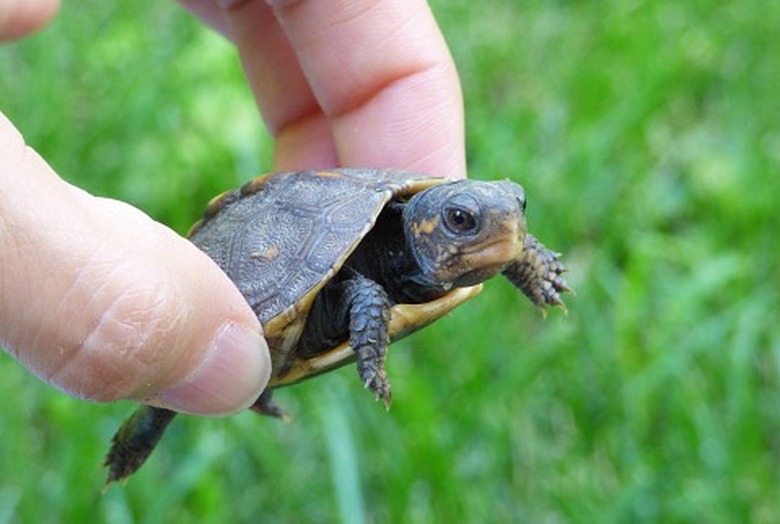What Do Baby Turtles Eat? Here's What Foods You Can Feed Baby Turtles
A young, growing turtle has a significantly different diet from that of their full-grown brethren. Their habitat and physical form do not extensively differ from hatchling to adult, but in general a baby turtle will eat more protein than plant matter, whereas adult turtles are omnivorous, in most cases. Mixing baby turtle food at home is possible if you know the needs of your type of turtle.
For instances, tortoises remain herbivores from babies to adult, but vitamin control is important as hatchlings. The diet of any given turtle from birth to adulthood will depend entirely on its species — different turtles have different diets but many pet stores sell species-specific turtle pellets.
Baby box turtle diet
Baby box turtle diet
The most common land turtle in the pet trade is the box turtle. Named for their hinged shell, which they can close around their head, legs and tail, sealing themselves up like a box, box turtles as adults are omnivorous — they eat plants and meat. As hatchlings, however, box turtles will prefer meat over greens. Baby box turtles in the wild feast on whatever insects are available to them, but in captivity, you can finely chop and feed the following baby turtle food at home:
- Tubifex worm
- Mealworms
- Chopped-up nightcrawlers and earthworms
- Small crickets
- Green lettuce
- Tomatoes
- Beans
- Melon, apricot or banana as a special treat
Offer both meat and plant matter to your box turtle babies, once every other day. They likely will refuse all plant matter for the first 8 to 10 weeks, but they instinctively know what vitamins and minerals they need and will adjust their diet when their internal clock tells them to. Allow feeding for an hour and remove uneaten morsels to keep the area clean.
Baby red-eared slider diet
Baby red-eared slider diet
One of the most common semiaquatic turtles currently in the pet industry is the red-eared slider. Like their box turtle brethren, adult sliders are omnivores, but with their primary habitat being lakes, ponds, and streams, sliders have access to different sources of meat and plants. As before, offering a mixture of plant and protein will ensure your turtle grows up healthy and strong. They can eat the following:
- Turtle pellets labeled for red-eared slider consumption
- Dandelion leaves
- Green lettuce
- Aquatic plants, such as water lily, Anacharis, duckweed, water fern and water hyacinth
- Small apple and pond snails
- Guppy fry
- Earthworms, silkworms and mealworms
While the box turtle should be fed fresh food, less often, red-eared slider babies should be fed daily, and the primary staple of their diet should be protein-rich and nutritionally balanced turtle pellets labeled especially for this species of turtle.
Baby red-footed tortoise diet
Baby red-footed tortoise diet
While land and semiaquatic turtles grow up to be omnivores, tortoises remain herbivores for their entire lives. In this class, the most common pet is the red-footed tortoise. Because they are vegetarians, ensuring the proper balance of vitamins and minerals is key. Your red-foot can eat the following finely chopped food:
- Chickweed
- Henbit
- Dandelion leaves
- Plantain
- Grape leaves
- Hibiscus blooms and leaves
- Chicory
- Escarole
- Collared greens
- Strawberry, cantaloupe, plum, peach, pineapple and prickly pear cactus as fruits
Feeding aquatic turtles
Feeding aquatic turtles
Feed baby and juvenile aquatic turtles daily, but feed adults two to three times a week. To avoid soiling the habitat with excess food waste, consider feeding aquatic freshwater turtles — snapping turtles, red ear sliders, and soft-shell turtles — in a container other than the main tank. This will prevent food from falling to the bottom of the tank and affecting water quality. Also, use a floating or magnetic veggie clip to hold leafy greens and veggies for aquatic turtles to munch on. The clip will prevent heavier veggies from sinking to the bottom of the tank.
Feed baby and juvenile semi-aquatic turtles daily and adults every two to three days. Feed semi-aquatic turtles, like box turtles and Reeve's turtles, off a shallow plate or slate tile, on land. Wait until mid-morning, after the turtle has had time to wake up and warm up before feeding.
Feeding and eating problems
Feeding and eating problems
In the wild, some tortoises can survive without food up to three months. How long a turtle can survive with no access to food also depends upon his stored fat pads. For younger turtles, bring out the tasty big guns with live protein such as crickets, mealworms, and beetles. Tempt turtles of the older variety by beckoning their sweet tooth: Use strawberries and bananas to coax them to eat.
If all else fails, and your pet turtle is simply refusing to eat, get him to your reptile vet for a full blood checkup. The vet will check for common culprits such as parasites, infections, or vitamin deficiencies. With proper treatment, your little guy will be back on his way to munching his favorite turtle foods.
